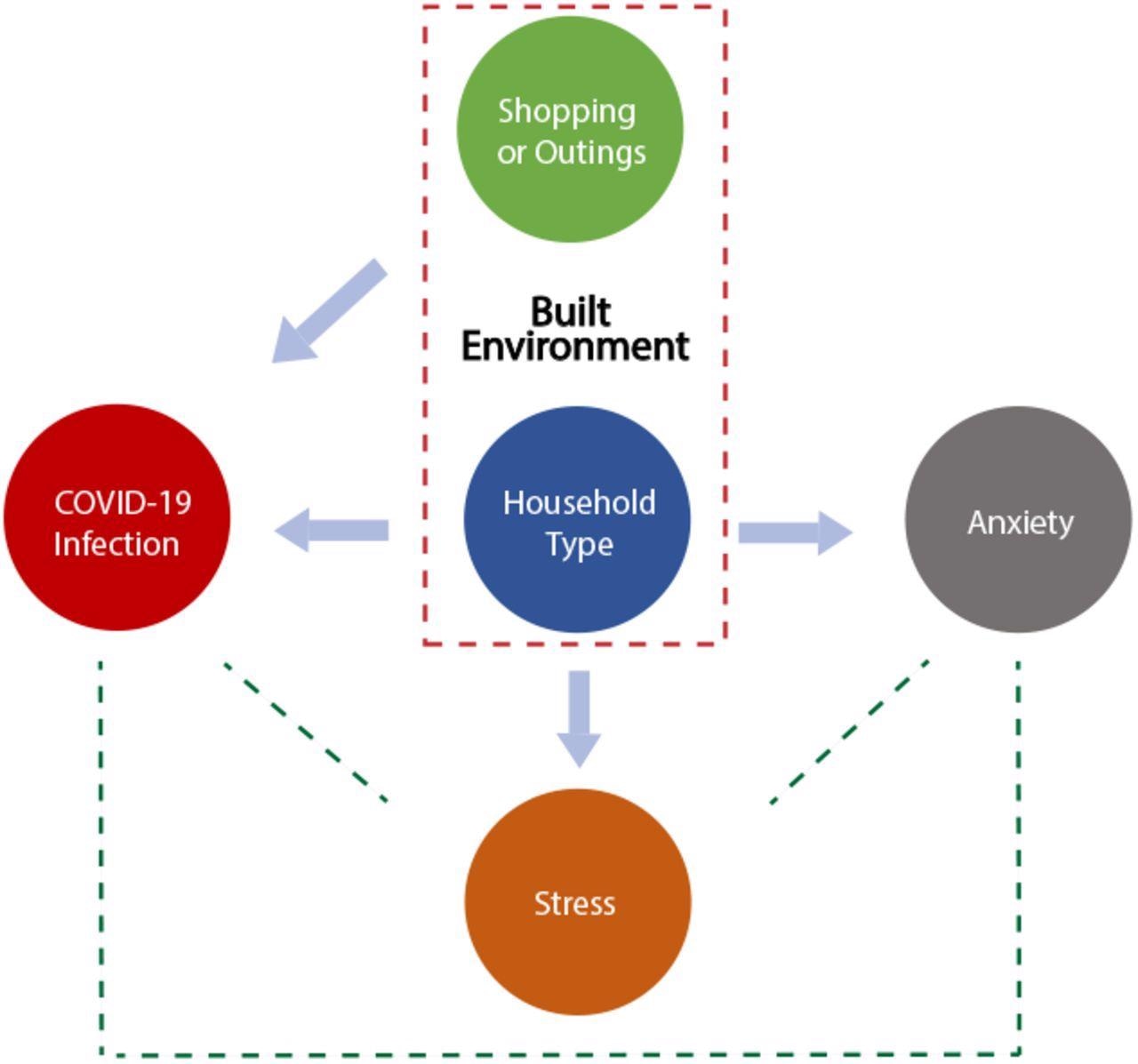The ongoing severe acute respiratory syndrome coronavirus 2 (SARS-CoV-2) pandemic has led to over six million deaths worldwide. SARS-CoV-2 transmission occurs via the inhalation of air contaminated with the respiratory fluids of COVID-19 patients, aerosol transmission if there is an inadequate air ventilation rate, high air recycling in a closed environment, and from the SARS-CoV-2-contaminated surfaces and subsequent touching of body mucous membranes. Therefore, SARS-CoV-2 transmission must be effectively reduced to minimize the effects of the COVID-19 pandemic.
Previous reports discovered a possible association between SARS-CoV-2 transmission and the built environment. Nevertheless, rigorous studies assessing these connections at the individual level are still lacking, possibly due to the high expense of data acquisition.
 Study: Built environment’s impact on COVID-19 transmission and mental health revealed by COVID-19 Participant Experience data from the All of Us Research Program. Image Credit: BABAROGA / Shutterstock
Study: Built environment’s impact on COVID-19 transmission and mental health revealed by COVID-19 Participant Experience data from the All of Us Research Program. Image Credit: BABAROGA / Shutterstock

 This news article was a review of a preliminary scientific report that had not undergone peer-review at the time of publication. Since its initial publication, the scientific report has now been peer reviewed and accepted for publication in a Scientific Journal. Links to the preliminary and peer-reviewed reports are available in the Sources section at the bottom of this article. View Sources
This news article was a review of a preliminary scientific report that had not undergone peer-review at the time of publication. Since its initial publication, the scientific report has now been peer reviewed and accepted for publication in a Scientific Journal. Links to the preliminary and peer-reviewed reports are available in the Sources section at the bottom of this article. View Sources
About the study
In the present study, the researchers examined the association between COVID-19 or mental health and household types during the initial stages of the SARS-CoV-2 pandemic using the All of United States (US) Research Program (AllofUsRP) COVID-19 participant experience (COPE) survey information. The AllofUsRP is the largest biobank project in the US and has conducted six types of comprehensive, large-scale COPE surveys between 2020 and 2021.
From the responses of 62,664 people to COPE between May and July 2020, the authors compared the cases of self-reported SARS-CoV-2 status, stress, or anxiety with controls of the same gender, race, survey version, and age group.
Structural Query Language (SQL) was used for data extraction, guided by the abovementioned covariates and outcomes (COVID-19 or mental health). The researchers performed several logistic regressions between household type and one of the outcomes after controlling other associated covariates, like age, ethnicity, house occupancy, and social distancing behavior.
Findings and discussions
The study results showed that the household kind was correlated with mental health (stress and anxiety) and COVID-19 transmission during the early phases of the SARS-CoV-2 pandemic. The study data also depicted that people with more frequent outings or shopping had higher chances of SARS-COV-2 infection.
Inhabitants of rehab facilities or nursing homes had a substantially higher risk of contracting COVID-19 than those in free-standing residences. An exact inference was obtained in the stratification analysis conducted utilizing the same age.
Furthermore, even after controlling for the confounding effect of the number of residents in the house, three or more-bedroom flat dwellers exhibited a greater likelihood to contract COVID-19. Meanwhile, the findings for one-bed or two-bedroom apartments were underpowered and inconsistent in some age cohorts, probably due to decreased household occupancy. Although unmodeled confounding factors such as interactions with workers and visitors cannot be ruled out, the likelihood of effect from the built environment was high due to the reproducibility of the findings and strict controls in the stratified analyses.
In the case of mental health, homeless people who resided in apartments with shared living spaces reported more anxiety than the residents of free-standing homes. This backed up previous reports and was partly due to the close quarters. Additionally, all of the findings indicated that shared components in built environments contributed to COVID-19 transmission and placed mental burdens on residents during the SARS-CoV-2 pandemic.
SARS-CoV-2-positive cases were high among people with more frequent non-essential shopping behaviors, i.e., three or more days in the past five days, compared to people who did not shop frequently. Outing and shopping might associate with the built environment because a significant number of shoppers mix indoors during the SARS-CoV-2 pandemic, offering shared locations for viral transmission. Furthermore, frequent shoppers below 20 years of age demonstrated a decline in stress.
Of note, the authors failed to differentiate the casual association between COVID-19 and mental disease as the study lacked longitudinal data.

Relationships among the household type, COVID-19 infection, mental health, and non-essential shopping or outings. Arrows indicate associations between the built environment and its impact outcomes, while dotted lines show the confounding associations among the outcomes.
Conclusions
The study findings indicated that the household type with a common component was dramatically linked with SARS-CoV-2 infection, stress, and anxiety relative to free-standing houses following the adjustment of several confounding elements. Additionally, another sign of the built environment, frequent outings or non-essential shopping, was also linked with SARS-CoV-2 infection, yet not correlated with heightened mental health conditions.
Overall, the present work illustrated that the built environment of houses with a common element increases the chance of SARS-CoV-2 transmission, resulting in elevated stress and anxiety among the residents. The study also emphasized the importance of enhancing the quality of the built environment via design, management, and planning to establish a more resilient society that is capable of dealing with any future contagious or airborne viral pandemics.

 This news article was a review of a preliminary scientific report that had not undergone peer-review at the time of publication. Since its initial publication, the scientific report has now been peer reviewed and accepted for publication in a Scientific Journal. Links to the preliminary and peer-reviewed reports are available in the Sources section at the bottom of this article. View Sources
This news article was a review of a preliminary scientific report that had not undergone peer-review at the time of publication. Since its initial publication, the scientific report has now been peer reviewed and accepted for publication in a Scientific Journal. Links to the preliminary and peer-reviewed reports are available in the Sources section at the bottom of this article. View Sources
Journal references:
- Preliminary scientific report.
Built environment’s impact on COVID-19 transmission and mental health revealed by COVID-19 Participant Experience data from the All of Us Research Program; Wenting Luo, Edwin Baldwin, Anna Yi Jiang, Shujuan Li, Bo Yang, Haiquan Li, medRxiv preprint 2022, DOI: https://doi.org/10.1101/2022.04.05.22273358, https://www.medrxiv.org/content/10.1101/2022.04.05.22273358v1
- Peer reviewed and published scientific report.
Luo, Wenting, Edwin Baldwin, Anna Yi Jiang, Shujuan Li, Bo Yang, and Haiquan Li. 2022. “Effects of Housing Environments on COVID-19 Transmission and Mental Health Revealed by COVID-19 Participant Experience Data from the All of Us Research Program in the USA: A Case–Control Study.” BMJ Open 12 (12): e063714. https://doi.org/10.1136/bmjopen-2022-063714. https://bmjopen.bmj.com/content/12/12/e063714.